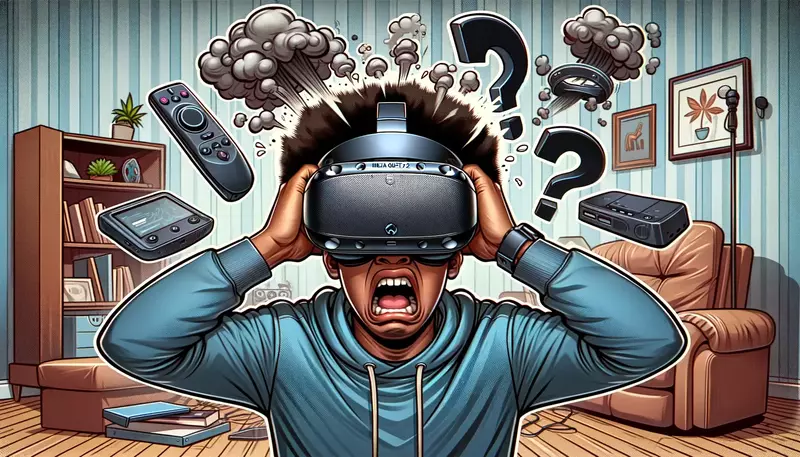This site contains affiliate links to products, and we may receive a commission for purchases made through these links.
Virtual reality (VR) is a computer technology that creates an immersive experience for users by simulating a three-dimensional environment. But what are virtual reality pre-rendered frames?
Pre-rendered frames were first available through the Nvidia control panel with the intent to lower latency. Essentially, it allows the CPU to queue up frames with pre-rendered frames to be processed by the graphics card (GPU). Nvidia later changed the name of this feature to Ultra-Low Latency Mode.
This article will explain what pre-rendered frames do and how they can impact your gaming experience.

What Are Virtual Reality Pre-Rendered Frames?
Virtual Reality is quickly becoming one of the most popular forms of entertainment. With headsets like the Oculus Rift and HTC Vive, users can experience immersive 3D environments that are completely unique to them.
The only problem is that these headsets require powerful computers in order to run properly. This has led to a dilemma for developers: how do they create virtual realities that are both visually appealing and playable on a limited budget?
One solution is to pre-render frames before actually creating the virtual reality environment. This allows developers to create high-quality visuals without having to worry about the performance implications.
Additionally, this process can be accelerated using dedicated hardware acceleration cards (GPU). As long as your computer has enough power, you can make your virtual reality as realistic or fantastical as you desire!
READ MORE! Will True Virtual Reality Ever Exist? (Explained!)
Nvidia introduced a useful feature to help keep frame rates up back around 2015. They called it Maximum Pre–Rendered Frames, also known as Max Frames to Render Ahead.
They added pre-rendered frames as a setting in the Nvidia control panel for users to change the settings themself. It essentially allows the CPU to queue up frames with pre-rendered frames for processing by the graphics card. Nvidia claims that this feature can reduce rendering time by up to 50%.
With the settings back in 2015, the value could be specified between 1 and 4. What this number is saying is that if you have the settings on 4, you will allow the CPU to pre-render 4 frames for the graphics card to put on the monitor.
Pre-rendered Frames keeps the GPU constantly fed with tasks, so when one task completes, the GPU already knows what to do and immediately begins the next task in the queue. If the GPU can’t keep up it might result in input lag because the GPU is a few frames “behind.”
Since the purpose is to lower latency by putting more of the work on the CPU, it’s important to note that this function will work best on GPU-heavy games.
Games like CS:GO that uses the CPU for most of the rendering will not have a positive effect from this feature.
This is because the CPU needs to use a lot of its workload to pre-render frames. This workload should instead be used on physics in the game and might also result in input lag in game.
Today, this feature is called Ultra-Low Latency Mode.
What Should I Set Virtual Reality Pre-Rendered Frames Settings Too?
The frame rate is the most important factor to consider when selecting a pre-rendering setting. The frame rate refers to how often each frame is displayed. The higher the frame rate, the more realistic the image will appear. So you want to increase this as much as possible.
If you have a game that requires a high-performance graphics card (GPU) to play at ultra-high settings, you can have the CPU assist the graphics card by pre-rendering frames before sending them to the graphics card to preview the display.
So, in theory, if you set the pre-rendering frames to maximum, you will obtain greater framerates in the game. You can also prevent frame skips in VR.
However, this is heavily dependent on the performance capabilities of your CPU. You’ll need a powerful CPU to perform the pre-rendering frames at their highest settings. Input lag will most likely occur if the CPU is unable to handle the task.
Because the pre-rendering settings are heavily dependent on CPU performance, I recommend experimenting with different values to see how they affect input lag and framerate.
READ MORE! Can I Get Virtual Reality On My Playstation 4? (Solved!)
What Does Nvidia’s Ultra-Low Latency Mode do?
Maximum pre-rendered frames from Nvidia used to be a popular feature in their graphics cards. However, Nvidia improved their Max Pre-Rendered Frames mode and renamed it Ultra-Low Latency Mode.
The new functionality, which has been renamed and improved, has been streamlined (both in name and performance).
The purpose of Ultra-Low Latency Mode is still the same as when they called it Max Pre-Rendered Frames. It renders a scene with the CPU processor before it is rendered to the graphics card (GPU), which can save on processing time and increase framerate.
They changed the settings from using the metrics 1 to 4, and are now using Off, On, or Ultra.
With the settings set to “Off” the CPU will automatically queue 1-3 pre-rendered frames before sending them to the Graphics card. The purpose is to use the CPU to help the GPU to increase higher frame rates. But as mentioned, this can increase the chance of input lag if the CPU is not strong enough.
If you put the settings to “On” it means that the CPU set a limit to the pre-rendered frames to 1 before sending it to the graphics card to display the picture. This is the same setting as 1 when the setting was called “Max Pre-Rendered Frames”.
If you put the settings on “Ultra” you give all the rendering work to the graphics card. This is the best option if you have a really powerful graphics card that can handle the workload.
How Do I Enable Pre-Rendered Frames In VR?

Right-click your desktop, select “NVIDIA Control Panel,” then on the top left, select “Manage 3D settings,” and finally, select “Low Latency Mode”. Here you can adjust the settings to your liking.
To enable pre-rendered frames in your VR software you can check if the following settings can be changed:
- Open the VR software and go to the settings menu
- Under Display, select Rendering Mode
- Change the setting from “Direct” to “Pre-Rendered”
FAQ
What is the difference between Maximum Pre-Rendered Frames and Virtual Reality Pre-Rendered Frames?
Maximum Pre-Rendered Frames is for computer games played on a normal monitor. You can choose to apply the global settings on each of these options or differentiate.
What is the difference between “Maximum Pre-Rendered Frames” and “Ultra-low latency mode”
Conclusion
Pre-rendering frames are used to render a scene with the CPU processor before it is rendered to the graphics card (GPU), which can reduce processing time and increase framerate.

Espen
Espen is the Director of PursuitMeta and has written extensively about Virtual Reality and VR Headsets for years. He is a consumer product expert and has personally tested VR Headsets for the last decade.




Leave a Reply